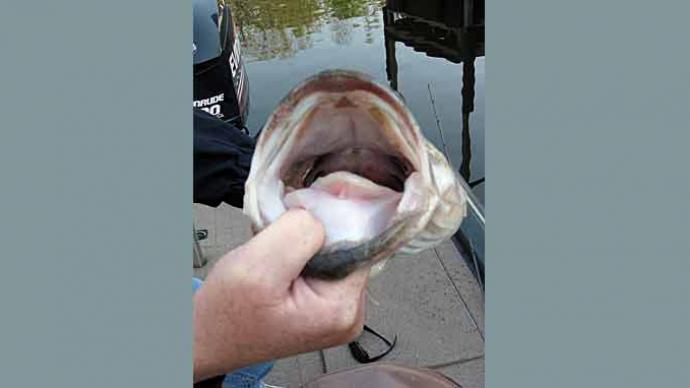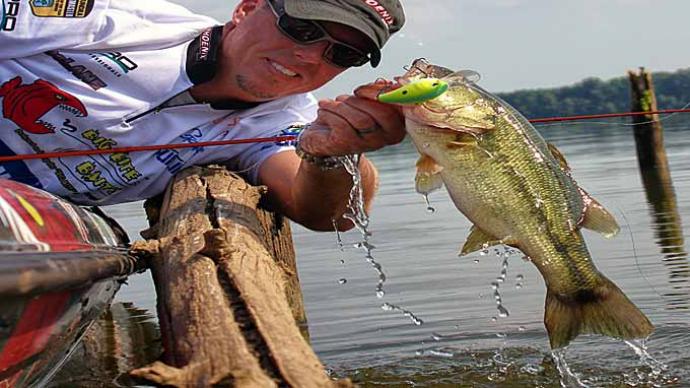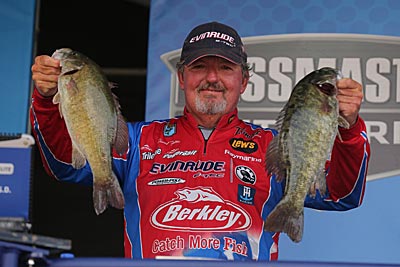
When Mother Nature turns up the heat and humidity, bass head offshore, following baitfish and seeking better water conditions. While a bevy of baits will catch them from these deep-water spots, including Carolina- and Texas-rigged soft plastics, drop shots, and giant flutter spoons, most bass anglers gravitate toward one lure — deep-diving crankbaits.
But getting the most bites with a deep-diving crankbait involves more than grinding one across the best ledges, humps, and other sunken spots. Rod, reel, line, and lure must work together. North Carolina-based Bassmaster Elite Series angler David Fritts knows a thing or two about making that happen. Crankbaits, especially deep divers, have played a role in many of his national bass tournament wins, five with B.A.S.S., including the 1993 Classic on Alabama’s Lake Logan Martin, and six with FLW, including the 1997 Forest Wood Cup on Mississippi’s Lake Ferguson.
Fritts wants to do two things with his deep-diving crankbait setup. First, the reigning king of crankbaits wants to make long casts. Secondly, he wants to feel everything his crankbait is doing — the way it vibrates, the type of cover it bounces off, and how the bass are biting it. Here’s how he accomplishes both.
Rod
If you want something done right, you have to do it yourself. That applies to the cranking rods that Fritts helped design for Lew’s Fishing. His signature Perfect Crankbait Speed Sticks are one of the brand’s most popular, he said, and fish spinnerbaits and vibrating jigs equally well.
The Fritts rods are available in five lengths. Choosing one comes down to a simple question. “A lot depends on how deep you want to fish,” Fritts said. Longer rods make longer casts. And the farther you throw your crankbait, the deeper it will dive. During the retrieve, there is a point where your crankbait starts to rise toward your rod tip. Before that is when it’s diving. So, the longer the cast, the farther the crankbait travels before reaching that point. “That’s huge when fishing,” Fritts said. “It can get [your crankbait] another 6 inches to 1 foot deeper.”
Fritts’ favorite rod is the most popular model in the series. “I like the 7-6,” he said. “It’s easy for you [in hot weather and fishing hard-pulling crankbaits].” He said it will cast a crankbait about eight more yards than the 7-foot rod. “And you’ll get 4 yards more with the 7-foot 11-inch model,” he said. “And if you’re a [tall] man, you can get the 9-foot rod.” It puts crankbaits into a different ballpark. “You can about spool the reel,” he said when casting with the wind.
The rods are offered in three powers: medium, medium, heavy and heavy. “I like the medium-heavy for big cranks,” Fritts said. He said it has a bit more flex, which makes casting easier. Heavy-action models do better at fishing the biggest crankbaits, though they and these lures demand more effort from the angler.
Fellow Bassmaster Elite Series angler and Classic champion Jay Yelas also prefers a long rod for fishing deep-diving crankbaits. He wants his to flex from handle to tip when under a load. He said slower action helps bass stay hooked by keeping his line tight. It also launches crankbaits farther.
Fritts said his signature rods are 92 percent fiberglass with the balance graphite. That blend creates the parabolic bend that Yelas says is so important while reducing weight, making it easier to cast all day. But at first glance, so much fiberglass might mean less sensitivity when compared to rods with more or all graphite. Fritts said that’s not the reality with these rods: “Not if you use the right reel.”
Reel
Over his more than 30-year tournament career, Fritts has seen many changes. One is the evolution of anti-reverse reels. When he first started fishing, most reels had some play. You could turn the handle — and spool — slightly backward before the reel locked against the drag. He said that bit of movement helped him feel what his crankbait was doing. If it bumped a log, for example, he could feel the impact in the reel when the handle moved backward.
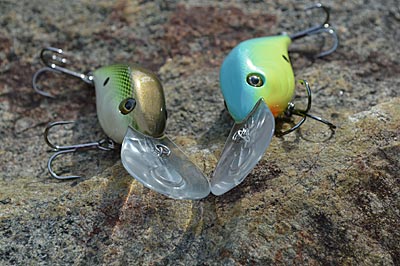
Engineers have eliminated that movement from nearly all of today’s casting reels. They feature infinite anti-reverse, which allows the handle only to turn forward. That’s great for techniques such as flipping when you need immediate rock-solid hook sets. But for Fritts, the improvement stole his feel. Lucky for him, there is a way to get it back.
Fritts fishes his deep-diving crankbaits with a Lew’s BB1 reel. Like its namesake, which Lew Childre introduced in the early 1970s and Fritts fished into the 90s, it has a multistop anti-reverse, creating the backward movement that Fritts wants. He said it has the same powerful gear ratio — 5.1:1 — that brings in 21 inches of line per handle turn as in the classic version. But it has more ball bearings and a lower profile, which adds casting distance and user comfort.
Line
Ask a group of bass anglers what type of line they tie to their deep-diving crankbaits, and fluorocarbon will be the most popular answer. And they aren’t wrong. It’s strong, stretches little, and resists abrasions, making it at home around sunken cover such as brush piles and shell beds. It also sinks, helping crankbaits run deeper. Yelas is among that group, preferring to throw his deep-diving crankbaits on 10- or 12-pound test fluorocarbon.
But fluorocarbon line isn’t what Fritts uses. “Fluorocarbon and I don’t get along,” he said. After three or four hours of fishing, he said it breaks from the stress his fishing style places on it. What he wants is a line that’s durable, sensitive, and easy to cast long distances.
Fritts prefers a monofilament such as Berkley Sensation. He also uses braided line such as Berkley X5. Both share an essential characteristic: little stretch. That increases sensitivity, letting him feel his crankbait better. “That’s the [reason behind] low stretch,” he said.
Good crankbait lines also have small diameters, Fritts said. They slice through the water more efficiently, allowing a crankbait to vibrate and dive deeper. In the case of monofilament, you’ll need to move to lighter pound tests to find thinner diameters. He said 10-pound monofilament, one of his favorite sizes for fishing deep-diving crankbaits, has a diameter of about .011 inches. But if you use a more indestructible braided line, you can double or triple the strength while matching the diameter.
Fritts acknowledges that a Palomar knot may be stronger, but he ties his deep-diving crankbaits with a uni knot, which he said is reliable and easy to tie. Start by threading the line through the eyelet or split ring and then creating a loop by passing the tag end over and along the main line. Wrap the tag around the main line and the loop portion that touches it five or six times before pulling it tight.
Fritts doesn’t spend much time considering the color of his line. He sticks with clear monofilament and green or smoke braided lines. “[Line color] doesn’t matter when winding a crankbait,” he said. “The fish don’t see your line. That bait has their attention.”
Lure
Crankbaits come in an endless selection of colors, sizes, and diving depths. All most bass anglers must do is count the tackle boxes they have stuffed to know that. But there are some shared traits among the best deep-diving crankbaits. Many were incorporated in Berkley’s Dredger series of crankbaits, which Fritts helped design.
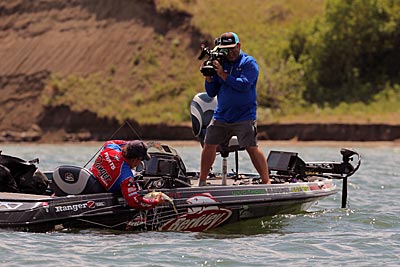
Fritts said three years of work went into the Dredger crankbaits. “I spent a lot of time in Iowa,” he said of his trips to Berkley’s factory and research-and-design lab. Much of that time reduced the lure’s profile while making it dive deeper. That was accomplished partly by flattening the bait's top, effectively making the bill longer.
With help from rod and reel, crankbaits need to fly well, too. “It still takes a long cast,” Fritts said. “The same person throwing the same setup can expect 3 or 4 more feet [casting distance] with the Dredger [than a comparably sized crankbait].” But it still takes effort on your part. “Go out and practice,” he said. “Learn to put speed and a load on your rod.”
Color is a situational choice. Chartreuse with blue back crankbaits, for example, work well in lakes where bass feed on shad, especially in the Mid-Atlantic states. But one color choice holds true almost everywhere. Fritts said crankbaits featuring muted — faded — colors work better for bass made finicky by fishing pressure. Aggressive bass, he said, are agitated into striking by bright colors.
Creating faded crankbaits used to be a process. Fritts would hang them from the rear view mirror of his truck or scatter them across its dashboard, letting the heat and sun work on them. But the paint and clear coat applied to modern crankbaits doesn’t fade, so he and Berkley found a way around that. “We paint some of them that way,” he said.
Fritts sticks to round bend treble hooks for his crankbaits, choosing Berkley’s Fusion19 hooks. He believes they are mechanically sharpened, which keeps them sharper longer than chemically sharpened ones. And he prefers trebles with long shanks. He loses too many bass on short-shanked hooks.
BassResource may receive a portion of revenues if you make a purchase using a link above.



